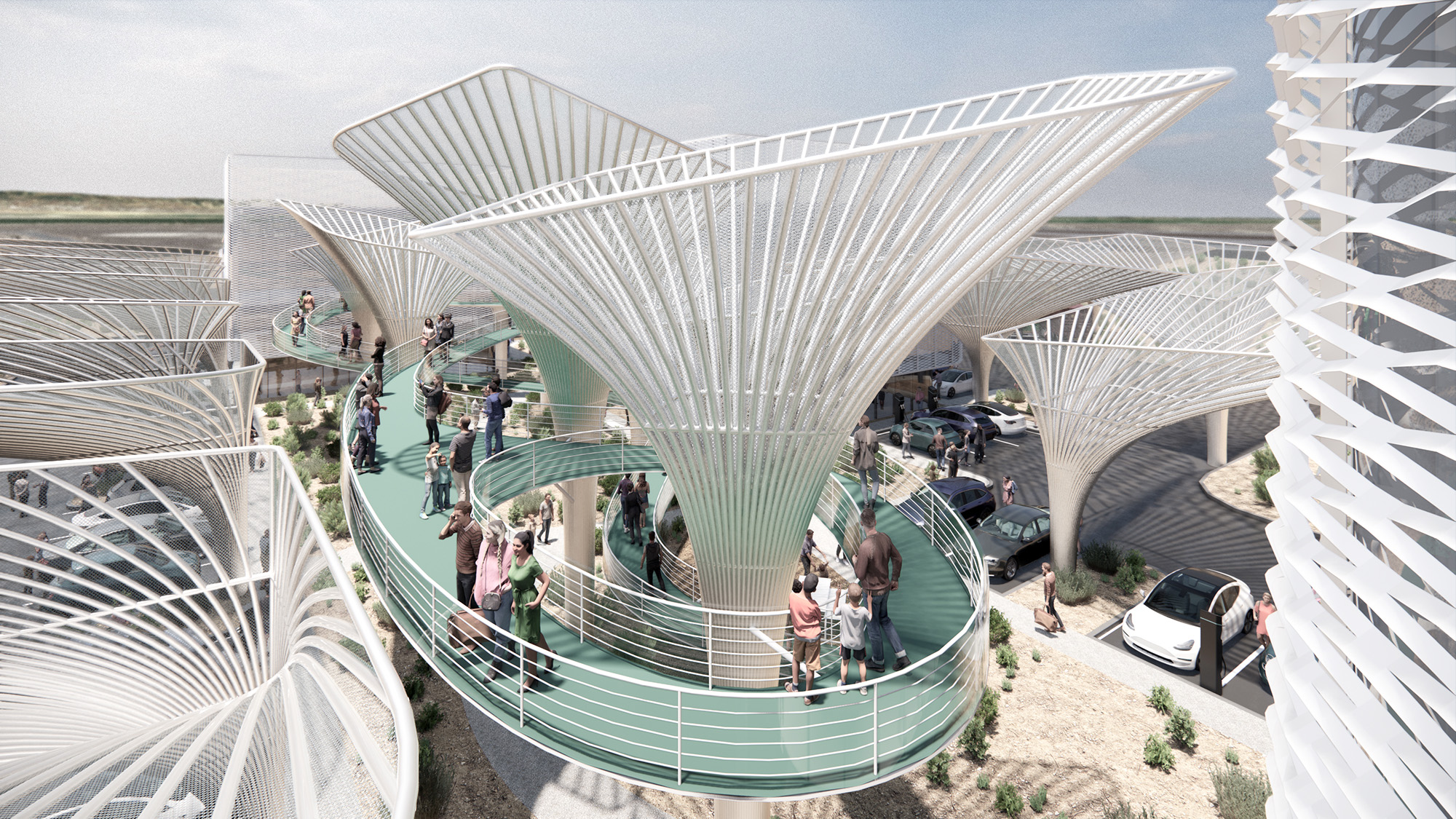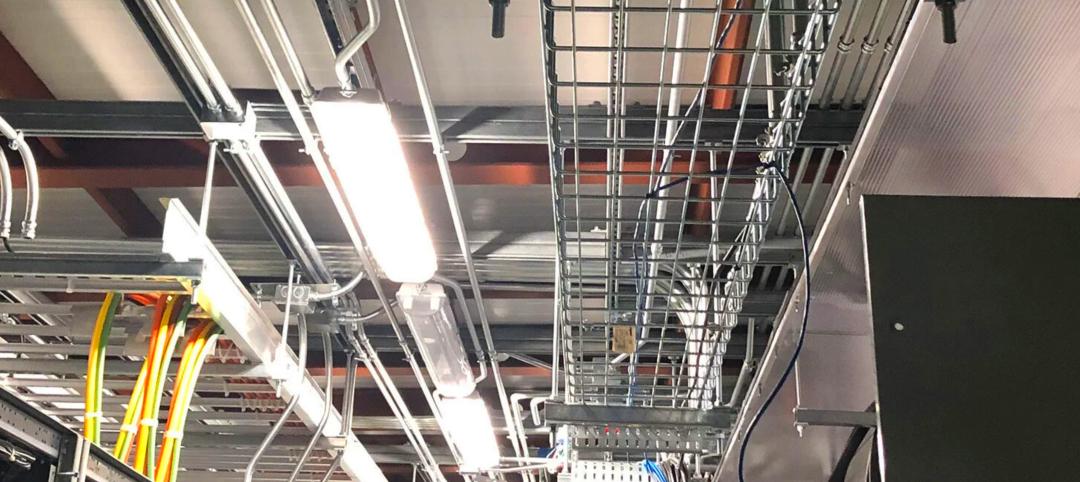A concept that would use structural steel to reinvent the gas station experience for the EV age has won the American Institute of Steel Construction’s 2023 Forge Prize. LVL (Level) Studio collaborators Jeffrey Lee, Christopher Taurasi, and Lexi White won the $10,000 grand prize in a YouTube live stream Thursday afternoon. They worked with Schuff Steel Senior Vice President Christian Crosby to refine their Electric Oasis vision and make the process of bringing it to life in steel more efficient.
The project team will give an encore presentation at Architecture in Steel at NASCC: The Steel Conference in Charlotte, N.C. at 11:30 a.m. on Wednesday, April 12.
The judges were particularly impressed by the team’s thoughtful approach, which turns a banal task into a destination event.
Electric Vehicle Landscape Reshaping Our 'Gas' Stations
“You’ve taken something very mundane that we give not a second thought to usually and injected a certain level of magic—not just waiting for the charging, but also what you can do with that time,” said Forge Prize Judge Melanie Harris, AIA, LSSYB, NCARB, who is the national healing practice director at BSA LifeStructures. “We’re all looking for efficiencies in our life these days and the last thing we want to do is wait around and do nothing while we wait for our cars to charge.”
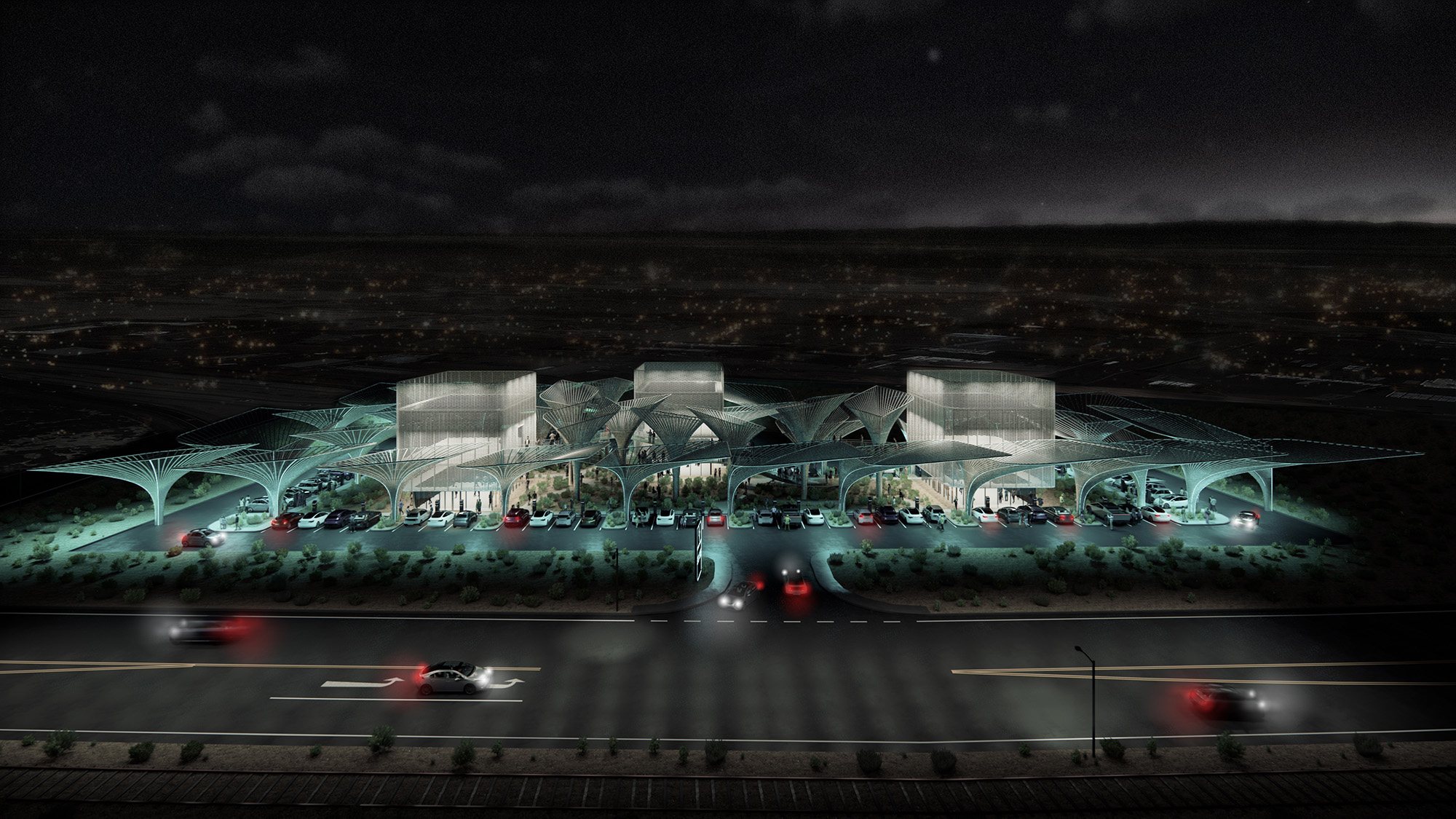
The time it takes to recharge is, the team noted, one of the primary differences between a gas and electric vehicle.
“On average, a gas stop takes around seven minutes to refill a tank,” Lee said. “A level-two charging station, which is the most common type, takes upwards of four and a half hours for a full charge. We have an opportunity to reimagine the gas station typology into something that can revitalize the local economy.”
So what to do with that time? In their vision, motorists would relax, work, play, shop, or perhaps even get healthcare while their vehicles charge—all activities that offer new economic opportunities for small communities around highway interchanges. These charging stations are defined by striking steel canopies that offer shade. In their primary use case, for a site within average EV range of both Los Angeles and San Francisco, a pathway winds through the canopies, offering vistas and an engaging space in a loop that takes about 15 minutes to explore.
The pathway connects buildings that would house retail and other spaces—with photovoltaic panels on the roof, naturally. Those hubs feature a steel scrim that is both beautiful and functional, providing shade that would reduce solar gain by up to three hours a day.
The design takes advantage of steel’s unique modular potential to facilitate economical, rapid erection—and steel’s unique recyclability and circular supply chain add an additional layer of sustainability while reinventing the existing infrastructure.
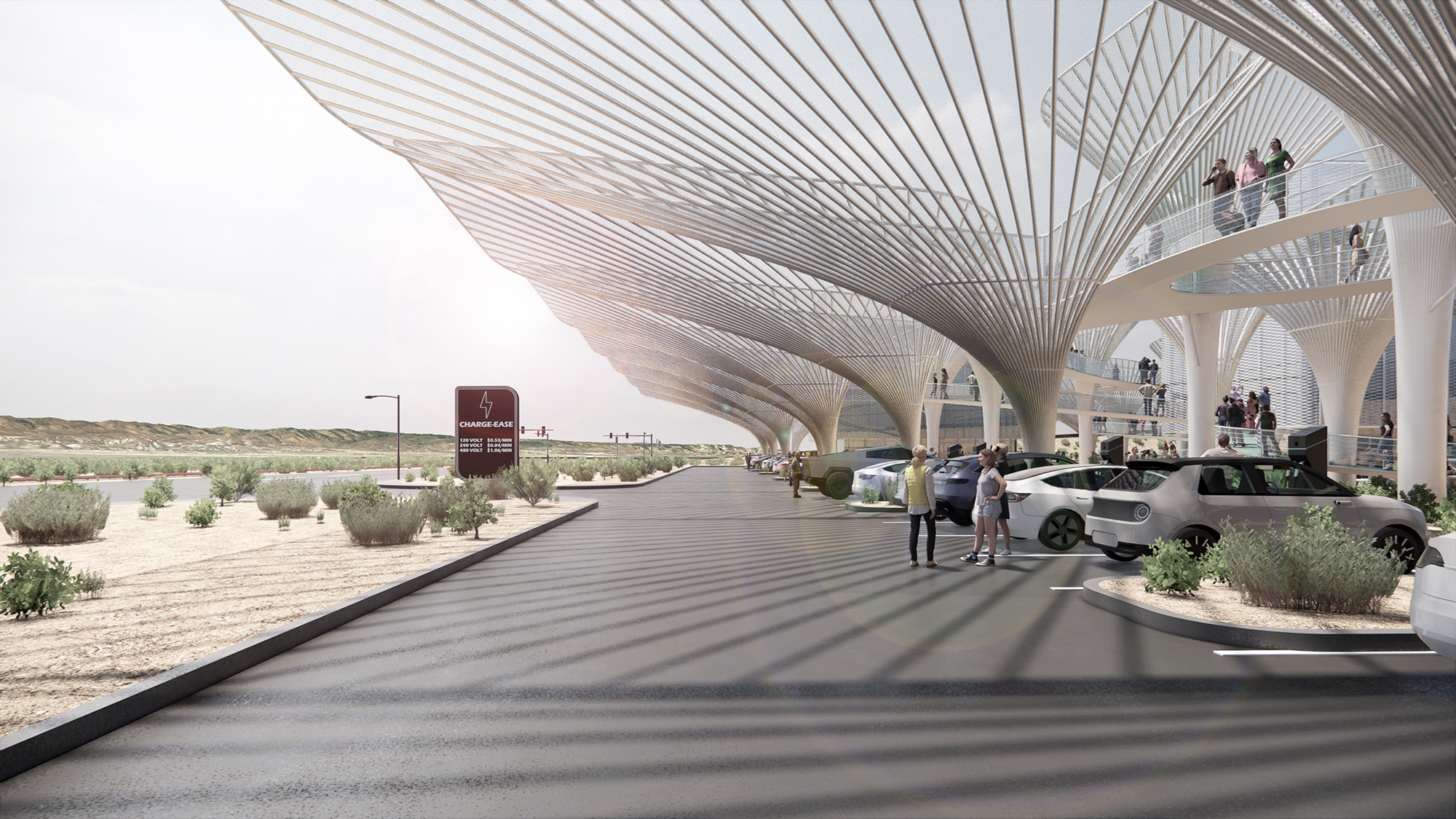
“This is a vehicular kind of society,” noted Forge Prize Judge Rona Rothenberg, FAIA, DBIA, the 2022 president of AIA California, noting that it’s applicable to a vast number of sites across the country. “This is a great way to reuse what we already have and transform it into a resilient, sustainable, and lasting solution.”
What motorists may not see while they’re enjoying the amenities: soil remediation. The design includes a mechanism to clean up any ground contamination left over from the site’s use as a gas station.
Forge Prize 2023 Finalists
LVL (Level) Studio was one of three finalists in the competition.
First runners-up Junior Carbajal and Masamichi Ikeda (both of JRMA Architects Engineers) won praise for their Adaptive Micro Cities design, which would create a self-sustaining virtual community with separate zones where people can live, work, and play all brought together with a series of modular boxes, to revitalize a small island in a Portland, Ore., industrial zone.
The judges were also impressed by the scale of second runner-up Then Le’s (Huntsman Architectural Group) Trans-connect multi-modal transportation hub and its thoughtful plan for everything from high-speed trains to electric airplanes in San Francisco.
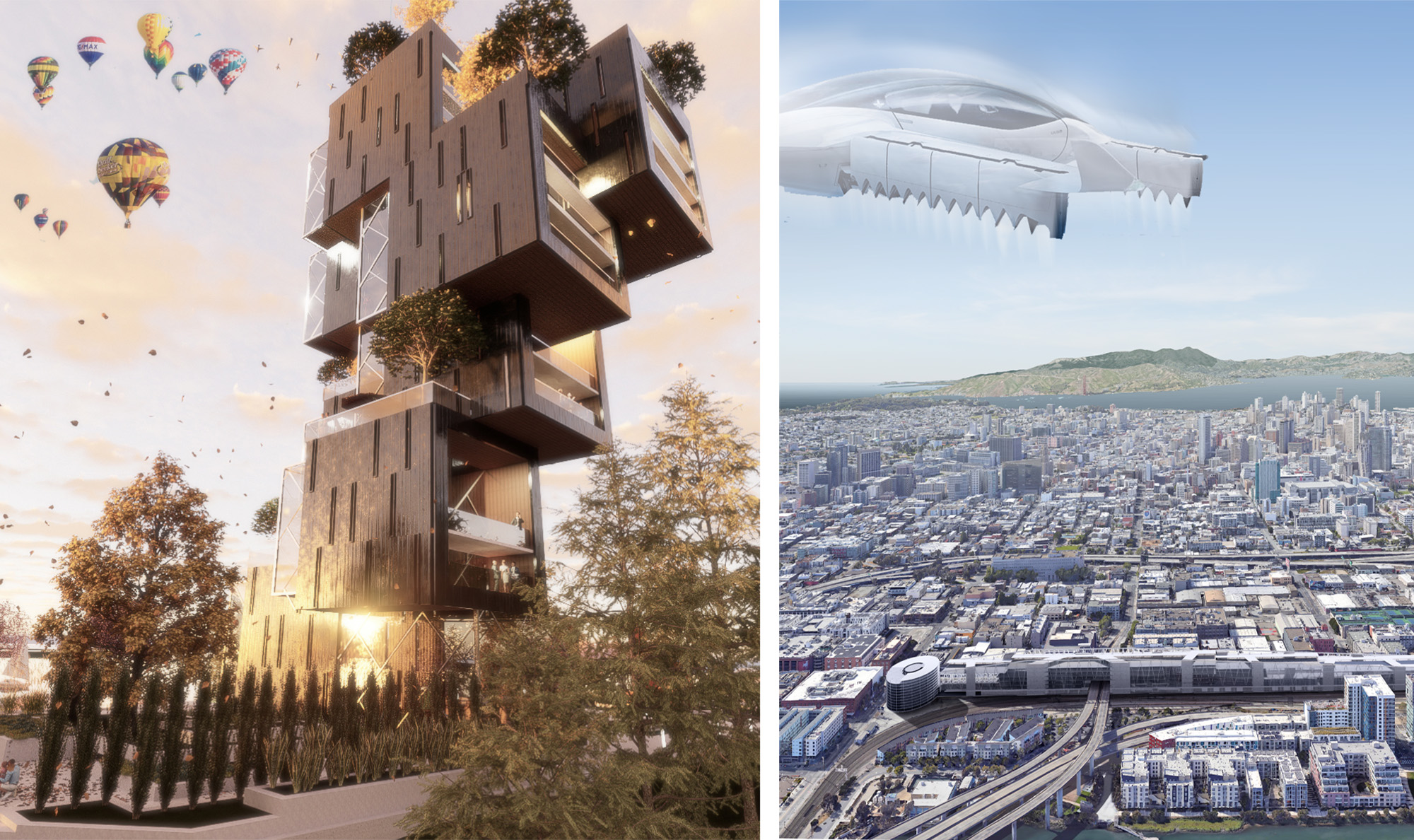
The American Institute of Steel Construction’s annual Forge Prize competition celebrates emerging architects who create visionary designs that embrace steel as the primary structural component while exploring ways to increase project speed.
AISC would like to thank Melanie Harris, Sean Joyner (writer & communications strategist at Perkins & Will), and Rona G. Rothenberg for serving as this year’s Forge Prize judges. High-res photos of all three projects are available here.
About the American Institute of Steel Construction
The American Institute of Steel Construction, headquartered in Chicago, is a non-partisan, not-for-profit technical institute and trade association established in 1921 to serve the structural steel design community and construction industry. AISC's mission is to make structural steel the material of choice by being the leader in structural steel-related technical and market-building activities, including specification and code development, research, education, technical assistance, quality certification, standardization, market development, and advocacy. AISC has a long tradition of service to the steel construction industry of providing timely and reliable information.
Related Stories
Modular Building | Mar 20, 2023
3 ways prefabrication doubles as a sustainability strategy
Corie Baker, AIA, shares three modular Gresham Smith projects that found sustainability benefits from the use of prefabrication.
Building Tech | Mar 14, 2023
Reaping the benefits of offsite construction, with ICC's Ryan Colker
Ryan Colker, VP of Innovation at the International Code Council, discusses how municipal regulations and inspections are keeping up with the expansion of off-site manufacturing for commercial construction. Colker speaks with BD+C's John Caulfield.
Affordable Housing | Mar 14, 2023
3 affordable housing projects that overcame building obstacles
These three developments faced certain obstacles during their building processes—from surrounding noise suppression to construction methodology.
AEC Innovators | Mar 3, 2023
Meet BD+C's 2023 AEC Innovators
More than ever, AEC firms and their suppliers are wedding innovation with corporate responsibility. How they are addressing climate change usually gets the headlines. But as the following articles in our AEC Innovators package chronicle, companies are attempting to make an impact as well on the integrity of their supply chains, the reduction of construction waste, and answering calls for more affordable housing and homeless shelters. As often as not, these companies are partnering with municipalities and nonprofit interest groups to help guide their production.
Modular Building | Mar 3, 2023
Pallet Shelter is fighting homelessness, one person and modular pod at a time
Everett, Wash.-based Pallet Inc. helped the City of Burlington, Vt., turn a municipal parking lot into an emergency shelter community, complete with 30 modular “sleeping cabins” for the homeless.
Multifamily Housing | Mar 1, 2023
Multifamily construction startup Cassette takes a different approach to modular building
Prefabricated modular design and construction have made notable inroads into such sectors as industrial, residential, hospitality and, more recently, office and healthcare. But Dafna Kaplan thinks that what’s held back the modular building industry from even greater market penetration has been suppliers’ insistence that they do everything: design, manufacture, logistics, land prep, assembly, even onsite construction. Kaplan is CEO and Founder of Cassette, a Los Angeles-based modular building startup.
Affordable Housing | Feb 15, 2023
2023 affordable housing roundup: 20+ multifamily projects
In our latest call for entries, Building Design+Construction collected over 20 multifamily projects with a focus on affordable housing. Here is a comprehensive list of all projects in alphabetical order.
Data Centers | Feb 6, 2023
Modular electric rooms are the new normal
Southland Industries breaks down the prefabrication benefits of Modular Electric Rooms (MERs).
Multifamily Housing | Feb 3, 2023
HUD unveils report to help multifamily housing developers overcome barriers to offsite construction
The U.S. Department of Housing and Urban Development, in partnership with the National Institute of Building Sciences and MOD X, has released the Offsite Construction for Housing: Research Roadmap, a strategic report that presents the key knowledge gaps and research needs to overcome the barriers and challenges to offsite construction.
Augmented Reality | Jan 27, 2023
Enhancing our M.O.O.D. through augmented reality therapy rooms
Perkins Eastman’s M.O.O.D. Space aims to make mental healthcare more accessible—and mental health more achievable.


